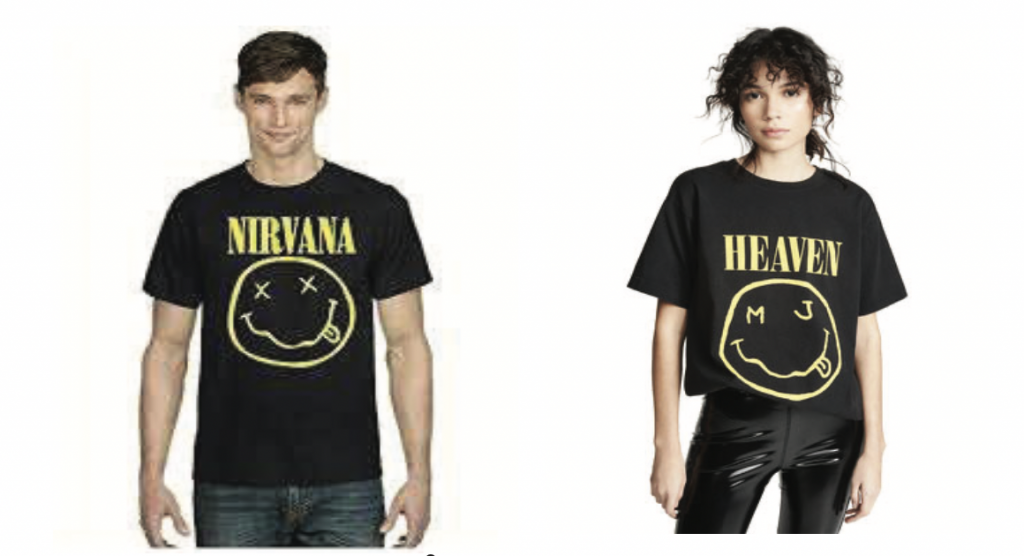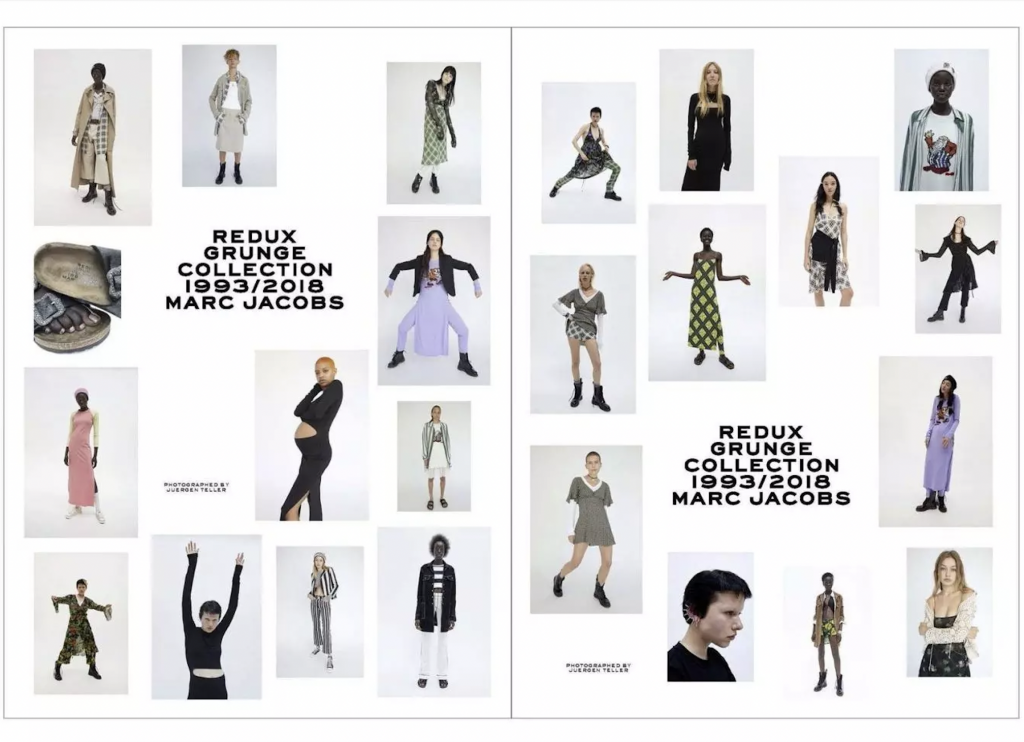Almost two years after Nirvana LLC lodged a trademark and copyright lawsuit against Marc Jacobs, the fashion brand initiated a separate – but related – fight over the smiley face design at the center of the parties’ ever-escalating suit. In a seeming attempt to chip away at the ongoing case that Nirvana LLC filed in December 2018, Marc Jacobs filed an opposition proceeding before the U.S. Patent and Trademark Office’s Trademark Trial and Appeal Board (“TTAB”), seeking to block Nirvana’s application for registration for the x-eyed smiley face for use on an array of different clothing items, as well as shoes, beanies, belts, scarves, and baseball caps, among many other things.
In its September 2019 opposition filing, counsel for Marc Jacobs argued that Nirvana LLC’s application should be tossed out because the band’s corporate entity, which was form in September 1997 surviving Nirvana members Grohl and Novoselic, along with Cobain’s widow Courtney Love, is “impermissibly seek[ing] to register a commonly-adopted and well-known ‘smiley face design’ for ornamenting” garments and accessories. According to Jacobs, the specific smiley face at play – one that Nirvana LLC says that it has used since the 1990s – “fails to function as a mark; lacks inherent or acquired distinctiveness; is a generic, universal symbol; [and] is merely ornamental and has not been used by [Nirvana] as a trademark.”
As for why – exactly – the specific smiley face fails to function as a trademark in the same way as other brands’ logos or source-identifying graphics, Marc Jacobs asserted in its filing that for one thing, the smiley face at issue comprises a universal symbol [that] conveys an informational message,” or more specifically, that expresses an emotion. In furtherance of this point, Jacobs argued that “the majority of mobile phone users have at their disposal a plethora of smiley face designs available to succinctly convey information or express emotion, including … stock smiley face designs with two x’s representing the eyes, and with a tongue sticking out of the mouth.”
“Notwithstanding any non-distinctive alterations of the universal smiley face symbol, the primary significance of [Nirvana’s mark] remains the original common expression of a smiley face design used to convey an informational message,” per Jacobs, and therefore, it “is incapable of any source identifying function.”
Counsel for LVMH Moët Hennessy Louis Vuitton-owned Marc Jacobs also argued that the symbol does not distinguish the products upon which it appears from those of other companies due to the fact that it is widely used in an “ornamental and decorative manner” by so many companies. The fashion brand claimed that it, for example, “has utilized smiley face designs ornamentally in connection with goods identical and/or related to [the various] goods covered by [Nirvana’s] application” (i.e., garments and accessories) “and has an interest in continuing to do so in the future.”
Given such “extensive third party use” by Jacobs and other brands, Jacobs claimed that “the consuming public is accustomed to encountering smiley face designs on clothing and other goods and services identical or related to [Nirvana’s clothing and accessories].” As a result, the average consumer would not consider the “pervasive, universally-recognized symbol as a source indicator for” Nirvana and its products, “and accordingly, [the smiley face] fails to function as a trademark.”

(This is a point that Jacobs made in a recent round of the parties’ ongoing lawsuit. The brand told the court that it had conducted a survey to “measure the degree to which, if at all, consumers associate the [Nirvana’s] smiley with [Nirvana] or another single, anonymous source.” In connection with that survey, Jacobs claimed that it found that out of 447 consumers (more than 72 percent of which were between the ages of 18-55), “only 10.8 percent of respondents viewed [Nirvana’s] smiley as associated with a single source, and only a mere 9 percent with [Nirvana]” specifically. The survey cuts against a finding of secondary meaning, according to Jacobs, which further asserts that Nirvana “does not run advertising featuring the smiley standing alone without the term NIRVANA, and there is no evidence of the type of ‘look for’ advertising directed at educating consumers as to the affiliation of the smiley with [Nirvana’s] business.”)
With the foregoing in mind, Jacobs told the TTAB that it would be damaged if Nirvana is able to register its smiley face – specifically, “a smiley face design with two x’s representing the eyes, a wiggly line curved upward representing the mouth, and a small open circle with a dash representing the tongue sticking out of the mouth” – as a trademark for use on an array of clothing, accessories, and footwear, and presumably, take action against others that use “confusingly similar” versions on their own wares.
In October, Nirvana responded to Jacobs’ opposition with a motion to suspend, alerting the TTAB to the pending civil action, and noting that “the claims in [Nirvana’s] complaint and [Jacob’s] affirmative defenses thereto, present issues and may have bearing on” on the opposition proceeding. Fast forward to January 9 and the TTAB granted Nirvana’s motion to suspend the opposition proceedings “pending final disposition of the civil action.”
Copyright Fight
Meanwhile, in court, the parties are currently going back and forth over the copyright-specific Motion for Partial Summary Judgment that Nirvana filed in early October. In the motion to dismiss, Nirvana LLC argues that despite any assertions to the contrary, it owns and maintains a valid copyright in its “Happy Face” t-shirt design. Nirvana claims that it has “continuously exploited the ‘Smiley Face’ design since [October 2, 1991 when [it] entered into a merchandising agreement with Giant Merchandising, Inc. to publicly release the ‘Happy Face’ t-shirt], selling tens of millions of dollars of ‘Happy Face’ t-shirts and other ‘Smiley Face’ merchandise in recent years.”
“Nirvana, Inc. filed the copyright registration for the ‘Happy Face’ t-shirt design in 1993, stating it was a work made for hire,” the holding company argues, noting that the group and its record label Geffen “always believed that Kurt Cobain created the ‘Smiley Face’ design on the front of the ‘Happy Face’ t-shirt … and that he did so on a ‘work made for hire’ basis as an employee of Nirvana, Inc.”
The issue of authorship – and thus, ownership – over the smiley face design has been complicated by the fact that former Geffen art director Robert Fisher has sought to join the case in September, alleging that he – and not Cobain – created the smiley face design for the band, and subsequently landed on the receiving end of a lawsuit from Nirvana LLC. According to the declaratory judgment complaint that it filed on November 11, Nirvana LLC alleges that “twenty-five years after the death of Nirvana band member Kurt Cobain,” Fisher has come forward, “claim[ing] to own a copyright interest in [the] Smiley Face’ design” and t-shirt design, which Nirvana registered with the U.S. Copyright Office in 1993.











